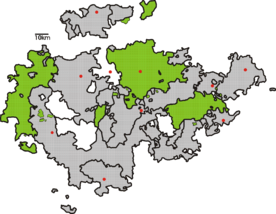Free State of Saxony-Weimar-Eisenach
| coat of arms | flag |
|---|---|

|

|
| Situation in the German Reich | |

|
|
| Arose from | Grand Duchy of Saxony |
| Incorporated into | State of Thuringia |
| Data from 1919 | |
| State capital | Weimar |
| Form of government | republic |
| Consist | 1918-1920 |
| surface | 3610 km² |
| Residents | 429,831 inhabitants |
| Population density | 119 inhabitants / km² |
| Religions | 94.4% ev. 4.8% Roman Catholic 0.8% others |
| Reichsrat | 1 vote |
| License Plate | S. |
| administration | 5 administrative districts |
| map | |

|
|
The Free State of Saxony-Weimar-Eisenach emerged from the Grand Duchy of Saxony after the First World War . It existed from November 1918 until it was merged with six other free and people's states to form Thuringia on May 1, 1920.
history
At the request of the Weimar Workers 'and Soldiers' Council , Grand Duke Wilhelm Ernst renounced his throne on November 9, 1918. The workers' and soldiers' council provisionally took over government affairs and was represented from November 12 by the chairman of the ten-member workers' council August Baudert as state commissioner and Hermann Leber (SPD) as commissioner for regulating nutrition issues.
On March 9, 1919, the elections for a new state parliament were held and on May 20, a coalition government consisting of Social Democrats and German Democrats was formed. State ministers were Arnold Paulssen ( DDP ) and August Baudert , State Councilors Adolf Hörschelmann ( SPD ), Philipp Kühner (DDP), Julius Palm (SPD), Emil Polz (DDP) and Albert Rudolph (SPD).
On May 15, the state parliament passed a new state constitution for the Free State, drafted by the Jena deputy of the DDP, Professor Eduard Rosenthal . This also served as a template for the future constitution of the state of Thuringia. With regard to the amalgamation with the other Thuringian states to form the new state of Thuringia , Parliament played a pioneering role in Thuringia and voted for accession on June 5, 1919 with 33 votes against 8.
With the establishment of the state of Thuringia on May 1st, 1920, the Free State of Saxony-Weimar-Eisenach formally ceased to exist as a sovereign federal state. The “Law on the Administration of the Former Thuringian States in the Transitional Period” of December 9, 1920 finally transformed the Free State into a higher-order municipal association with regional representation and regional government, which was finally repealed on April 1, 1923.
Election to the state parliament
- Election date: March 9, 1919
- Seats in the state parliament: 42
| Political party | Result | Seats |
|---|---|---|
| DDP | 21.60% | 10 |
| DNVP | 19.46% | 10 |
| DVP | 5.44% | 1 |
| SPD | 40.35% | 16 |
| USPD | 10.22% | 5 |
-
State government : Minister of State Arnold Paulssen (DDP) and August Baudert
State Councilors Adolf Hörschelmann (SPD), Philipp Kühner (SPD), Julius Palm (SPD), Emil Polz (DDP) and Albert Rudolph (SPD) - List of members of the state parliament (Free State of Saxony-Weimar-Eisenach)
literature
- Joachim Bergmann: The domestic political development of Thuringia from 1918 to 1932 . Europaforum-Verlag, Lauf an der Pegnitz 2001, ISBN 3-931070-27-1 ( Culture and history of Thuringia 16 = 19).
- Gregor Hermann: The transitional state parliament and the regional representation of Saxony-Weimar-Eisenach 1919–1923 . In: Harald Mitteldorf (Red.): The forgotten parliaments. State parliaments and regional representations in the Thuringian states and territories 1919 to 1923 . Published by the Thuringian Parliament. Hain, Rudolstadt u. a. 2002, ISBN 3-89807-038-7 ( writings on the history of parliamentarism in Thuringia 19).
- Thomas Herntrich: Thuringia. From the small states of Thuringia after the fall of the Old Kingdom to the Free State of Thuringia. A consideration of international and constitutional law (= writings on international and public law. Edited by Gilbert Gornig, plus dissertation Marburg 2010). Peter Lang, Frankfurt am Main 2010, ISBN 978-3-631-61024-4 .
